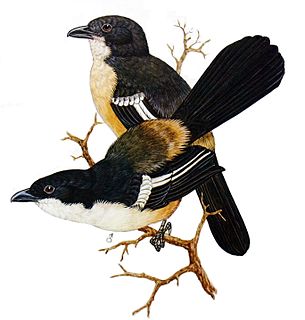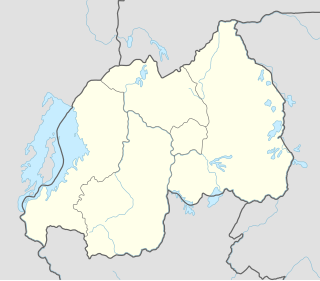
The yellow-crowned gonolek, also known as the common gonolek, is a medium-sized passerine bird in the bushshrike family. It is a common resident breeding bird in equatorial Africa from Senegal and Democratic Republic of Congo east to Ethiopia. It is a skulking bird and frequents dense undergrowth in forests and other wooded habitats. The nest is a cup structure in a bush or tree in which two eggs are laid.

The chestnut woodpecker is a resident breeding bird in South America from Colombia, Venezuela and the Guianas south to Ecuador, Bolivia and northern and western Brazil, and on Trinidad. It is found in a range of habitat types including rainforest, gallery forest, seasonally flooded forest, mangrove woodland, swamps, plantations and wooded savannah. It is a generally uncommon bird, and threatened by habitat loss, but it has a very wide range, and the International Union for Conservation of Nature has assessed its conservation status as being of least concern.

The southern boubou is a bushshrike. Though these passerine birds and their relations were once included with true shrikes in the Laniidae, they are not closely related to that family.

The crimson-breasted shrike or the crimson-breasted gonolek,, or the crimson-breasted boubou, is a southern African bird. It has black upper parts with a white flash on the wing, and bright scarlet underparts. The International Union for Conservation of Nature has rated it as a "least-concern species".

The tropical boubou or bell shrike is a medium-sized passerine bird of sub-Saharan Africa. This very diverse "species" with its numerous subspecies and morphs has since long posed a taxonomic problem, and recent research suggests it is a cryptic species complex that has now been split into several species.

The African cuckoo is a species of cuckoo in the family Cuculidae. It is found in Sub-Saharan Africa where it migrates within the continent, generally arriving and breeding in any one locality during the rainy season. A fairly common bird, the International Union for Conservation of Nature has rated its conservation status as being of "least concern".

The white-bellied cinclodes is a species of bird in the ovenbird family, Furnariidae. It is endemic to Peru where it inhabits high level, marshy grassland in the Junín Region and possibly also in the Huancavelica Region. This is a very large furnariid with dark upper parts and gleaming white underparts. It is a rare bird with very specific habitat requirements and is threatened by habitat destruction. The International Union for Conservation of Nature has assessed it as being "critically endangered".

The southern white-crowned shrike is a species of bird in the family Laniidae. It is found in Angola, Botswana, Mozambique, Namibia, South Africa, and Zimbabwe. Its natural habitats are subtropical or tropical dry forests and dry savannah.

The swamp boubou, also known as the Gabon boubou, is a species of bird in the Malaconotidae or bushshrike family. It is native to western and southern Central Africa. In the north of their range, savannah thickets constitute an important part of their habitat, while in the south they are strongly associated with river systems and marshes, for which they are named. The pair bond appears to be maintained by duetting, which in the south is generally synchronous or overlapping. It is most similar to L. major subsp. major, with which it perhaps hybridizes, but the underpart plumage is immaculate white, while the female contributes a ratchet-like note to the duet.

The black-headed gonolek is a species of bird in the family Malaconotidae. It is found in Burundi, Cameroon, Central African Republic, Chad, Democratic Republic of the Congo, Eritrea, Ethiopia, Kenya, Nigeria, Rwanda, Sudan, Tanzania, and Uganda.
Fülleborn's boubou is a species of bird in the family Malaconotidae. It is found in Malawi, Tanzania, and Zambia, where its typical habitat is humid montane forest, dense undergrowth, secondary growth, forest edges and bamboo groves. The name of this bird commemorates the German physician Friedrich Fülleborn.

The Uhehe fiscal is a bird in the family Laniidae. It is endemic to the uplands of southern and eastern Tanzania. Some taxonomic authorities treat this species as a subspecies of the southern fiscal. Despite its small population size and restricted range, the International Union for Conservation of Nature has rated this species as being of "least concern".

The mountain shrike or grey-capped shrike, is a species of bird in the family Laniidae. It is endemic to the Philippines.

Lagden's bushshrike is a bird species in the bushshrike family (Malaconotidae) native to Africa. It is a stocky bird with yellow or orange-yellow underparts, olive green upperparts, a grey head and heavy bill. Two subspecies are recognised, one found in west Africa and one in central Africa.

The white-bellied pitohui is a species of bird in the family Pachycephalidae. It is found throughout the lowlands of southern New Guinea (Lorentz River to upper Fly River.

The fire-bellied woodpecker is a species of bird in the family Picidae. It is found in Benin, Ivory Coast, Ghana, Guinea, Liberia, Mali, Nigeria, Sierra Leone, Togo and western Cameroon. A common species, the IUCN has assessed its conservation status as being of "least concern". Some taxonomic authorities place this species in Dendropicos.

The wildlife of Rwanda comprising its flora and fauna, in prehistoric times, consisted of montane forest in one third the territory of present-day Rwanda. However, natural vegetation is now mostly restricted to the three National Parks and four small forest reserves, with terraced agriculture dominating the rest of the country.

The Norfolk robin, also known as the Norfolk Island scarlet robin or Norfolk Island robin, is a small bird in the Australasian robin family Petroicidae. It is endemic to Norfolk Island, an Australian territory in the Tasman Sea, between Australia and New Zealand.

The Nyabarongo is a major river in Rwanda, part of the upper headwaters of the Nile. With a total length of 351 km (218 mi), it is the longest river entirely in Rwanda. It is extended 421 km (262 mi) in Lake Rweru including a 69 km (43 mi) upper course of Kagera River before joining into Ruvuvu River to form the Kagera River. The river begins its course at the confluence of the rivers Mbirurume and Mwogo in the South West of the country. These two rivers themselves begin in Nyungwe Forest, and are considered by some to be the most distant source of the Nile. From its start, Nyabarongo flows northward for 85 km, and forms the border between the Western and Southern Provinces. At the confluence with the river Mukungwa, the river changes course and flows eastward for 12 km, then to a more South Eastern course for the last 200 km. For the longest stretch of this course, the river serves as the boundary between the Northern and Southern Provinces, then between the City of Kigali and the Southern Province, and lastly between the City of Kigali and the Eastern Province.

The Rugezi Marsh is a protected area in Rwanda, covering 6,735 hectares. The wetland is one of headwaters of the Nile, situated in the Northern Province within the Buberuka Highlands. At 2,100 metres (6,900 ft), the marsh is a high altitude peat bog. Rugezi developed from an accumulation of organic materials within a quartzite rock-trapping water depression. In its natural state, Rugezi has been playing a significant ecological, hydrological, socio-economical, historic, and recreational role in Rwanda. It is also an Important Bird Area (IBA) recognized by the BirdLife International in 2001, and is reported to be the habitat of 43 species of birds within and in the surrounding areas of the marsh; the area of IBA is identified as ha8,500 hectares. The specific species of Grauer's swamp warbler and white-winged swamp warbler living together is reported as "unusual" by BirdLife International.





















